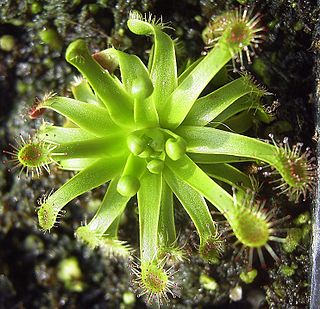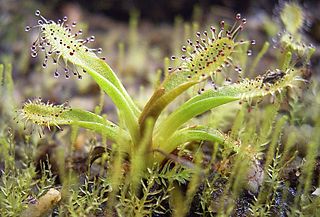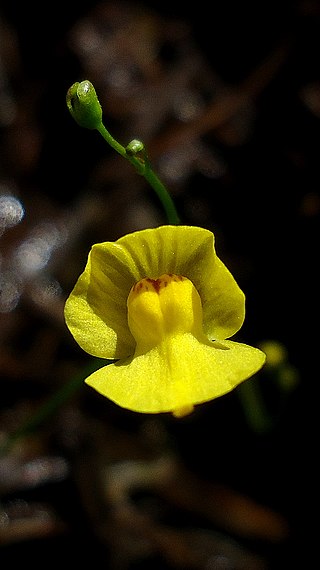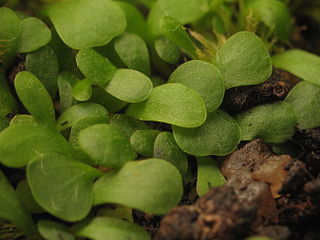
Drosera, which is commonly known as the sundews, is one of the largest genera of carnivorous plants, with at least 194 species. These members of the family Droseraceae lure, capture, and digest insects using stalked mucilaginous glands covering their leaf surfaces. The insects are used to supplement the poor mineral nutrition of the soil in which the plants grow. Various species, which vary greatly in size and form, are native to every continent except Antarctica.

Utricularia, commonly and collectively called the bladderworts, is a genus of carnivorous plants consisting of approximately 233 species. They occur in fresh water and wet soil as terrestrial or aquatic species across every continent except Antarctica. Utricularia are cultivated for their flowers, which are often compared with those of snapdragons and orchids, especially amongst carnivorous plant enthusiasts.

A number of introduced species, some of which have become invasive species, have been added to New Zealand's native flora and fauna. Both deliberate and accidental introductions have been made from the time of the first human settlement, with several waves of Polynesian people at some time before the year 1300, followed by Europeans after 1769.

Drosera capensis, commonly known as the Cape sundew, is a small rosette-forming carnivorous species of perennial sundew native to the Cape in South Africa. Because of its size, easy-to-grow nature, and the copious amounts of seed it produces, it has become one of the most common sundews in cultivation, and thus, one of the most frequently introduced and naturalised invasive Drosera species.

Drosera spatulata, the spoon-leaved sundew, is a variable, rosette-forming sundew with spoon-shaped leaves. The specific epithet is Latin for "spatula shaped," a reference to the form of the leaves. This sundew has a large range and occurs naturally throughout Southeast Asia, southern China and Japan, Micronesia, Papua New Guinea, eastern Australia, Tasmania and New Zealand. Variants are often known by the localities in which they are found. The plant does not form hibernacula in winter, and is easily grown using the same methods as Drosera capensis.

Drosera regia, commonly known as the king sundew, is a carnivorous plant in the sundew genus Drosera that is endemic to a single valley in South Africa. The genus name Drosera comes from the Greek word droseros, meaning "dew-covered". The specific epithet regia is derived from the Latin for "royal", a reference to the "striking appearance" of the species. Individual leaves can reach 70 cm (28 in) in length. It has many unusual relict characteristics not found in most other Drosera species, including woody rhizomes, operculate pollen, and the lack of circinate vernation in scape growth. All of these factors, combined with molecular data from phylogenetic analysis, contribute to the evidence that D. regia possesses some of the most ancient characteristics within the genus. Some of these are shared with the related Venus flytrap (Dionaea muscipula), which suggests a close evolutionary relationship.

Drosera peltata, commonly called the shield sundew or pale sundew, is a climbing or scrambling perennial tuberous species in the carnivorous plant genus Drosera. Among the tuberous sundews, D. peltata has the largest distribution, which includes eastern and western Australia, New Zealand, India, and most of Southeast Asia including the Philippines. The specific epithet is Latin for "shield shaped", a reference to the shape of the cauline leaves. It is either a single extremely variable species, or a complex of several closely related species of uncertain taxonomic boundaries. In Australia at least four forms have had or still have specific taxonomic recognition: Drosera peltata subsp. peltata, D. peltata subsp. auriculata, D. foliosa and D. gracilis.

Ammophila arenaria is a species of grass in the family Poaceae. It is known by the common names marram grass and European beachgrass. It is one of two species of the genus Ammophila. It is native to the coastlines of Europe and North Africa where it grows in the sands of beach dunes. It is a perennial grass forming stiff, hardy clumps of erect stems up to 1.2 metres (3.9 ft) in height. It grows from a network of thick rhizomes which give it a sturdy anchor in its sand substrate and allow it to spread upward as sand accumulates. These rhizomes can grow laterally by 2 metres in six months. One clump can produce 100 new shoots annually.

Drosera stenopetala is an insectivorous, rosette-forming perennial sub-alpine or alpine herb. The specific epithet means "with narrow petals", which is somewhat misleading given that the petals of this plant are fairly wide. A species of sundew, it is unique within its genus in being endemic to New Zealand. It is one of New Zealand's two alpine species of Drosera, the other being Drosera arcturi. Characteristic features include involute petioles and upright leaves. Its range extends from the Ruahine and Tararua Ranges in the north down the Southern Alps to Stewart Island. It is also found on the Auckland Islands and Campbell Island.

Drosera arcturi is a perennial, insectivorous species of sub-alpine or alpine herb native to Australia and New Zealand. It is one of New Zealand's two alpine species of sundew, the other being Drosera stenopetala. The specific epithet, which translates as "of Arthur" from Latin, is a reference to Mount Arthur, in north-eastern Tasmania, the type locality of the species.

Utricularia gibba, commonly known as the humped bladderwort or floating bladderwort, is a small, mat-forming species of carnivorous aquatic bladderwort. It is found on all continents except Antarctica.

Utricularia livida, the leaden bladderwort, is a species of flowering plant in the bladderwort family, native to central and southern Africa, and Mexico. Growing to 50 cm (20 in) tall and broad, it is a carnivorous perennial. It was originally described and published by Ernst Heinrich Friedrich Meyer in 1837.

Utricularia sandersonii, Sanderson's bladderwort, is a species of flowering plant in the bladderwort family. Originally described and published by the British botanist Daniel Oliver in 1865, it is a carnivorous evergreen perennial, endemic to northern KwaZulu-Natal and Transkei in South Africa.

Carnivorous plants are plants that derive some or most of their nutrients from trapping and consuming animals or protozoans, typically insects and other arthropods, and occasionally small mammals and birds. They still generate all of their energy from photosynthesis. They have adapted to grow in waterlogged sunny places where the soil is thin or poor in nutrients, especially nitrogen, such as acidic bogs. They can be found on all continents except Antarctica, as well as many Pacific islands. In 1875, Charles Darwin published Insectivorous Plants, the first treatise to recognize the significance of carnivory in plants, describing years of painstaking research.

Drosera gigantea, the giant sundew, is an erect perennial tuberous species in the carnivorous plant genus Drosera that is endemic to Western Australia. It grows in sandy soils at the margins of swamps and near granite outcrops along the Western Australian coast from Albany north to just south of Geraldton. D. gigantea produces small shield-shaped leaves along many lateral branches that look like a small tree. Individual plants can grow up to 0.2–1 m (0.7–3.3 ft) tall. Because of its tall, tree-like form, it is considered one of the largest Drosera species. It is also easily cultivated and enjoys damp, humid conditions often provided in greenhouses. White flowers emerge from August to November. The red tubers of this species can grow to be 3.8 cm (1.5 in) in diameter and may be a metre below ground.

The Bulletin of the Australian Carnivorous Plant Society was a quarterly periodical and the official publication of the Australian Carnivorous Plant Society. Established in April 1982 as Bulletin / South Australian Carnivorous Plant Society, it continued publication until 2003. In a special general meeting of society members, in September 2004, it was decided the bulletin would cease publication. Typical articles included matters of horticultural interest, field reports, literature reviews, and scientific studies. The headquarters was in Adelaide.

Australia has one of the world's richest carnivorous plant floras, with around 187 recognised species from 6 genera.

















